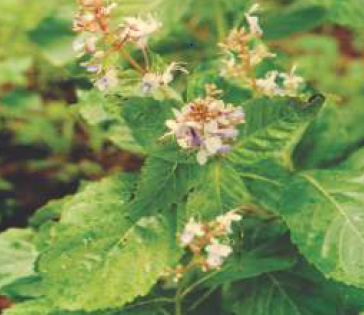Clerodendrum serratum
Clerodendrum serratum
Plant profile
| Family | Lamiaceae |
| Ayurvedic name | Bharangi |
| Unani name | Bharangi |
| Hindi name | Bharangi |
| English name | Blue-flowered Glory Tree |
| Trade name | Bharangi |
| Parts used | Roots and Leaves |

Clerodendrum serratum
Morphological Characteristics
- It is a small shrub, 2-4meter tall bearing opposite leaves and having woody rootstock.
- The plant has quadrangular, glabrous branches.
- Leaves are large and ovate or oblong, usually ternate whorled, coarsely and sharply serrate, glabrous and pale beneath with six pairs of lateral nerves.
Floral Characteristics
- Flowers are large pinkish-white in colour and numerous appearing in May to August month.
- It has a stout deflexed compressed pedicel in lax, dichotomous, long terminal panicles.
- It has leafy bracts and the calyx is cup shaped 5 mm long.
- Corolla is pale to pinkish blue with tube about 6-7 mm long; the lower larger lip like lobe is sky blue in colour.
- Stamens are long, exerted, curved and bluish.
- The drupes are 1-4 lobed, bluish-black and glossy.
Distribution
The plant is distributed over scrub forests throughout the tropical and sub-tropical parts upto 1500 m particularly in Bengal, Odisha and peninsular India.
Climate and Soil
Light to medium, particularly in laterite or red loam soils. It grows all over tropical and sub tropical regions.
Propagation Material
Stem cuttings of semi hard wood.
Agro-technique
Nursery Technique
- Raising Propagules: The stem cuttings are raised in polybags in the month of May and after establishing, the same may be transferred to the field.
- Propagule Rate and Pretreatment: Stem cutting to be treated in IBA 400 ppm for early sprouting.
Planting in the Field
- Land Preparation and Fertilizer Application: Ploughing and harrowing of field is done to bring the soil to fine tilth. Pits of 60X60X60 cm are prepared and organic manure (FYM) is mixed with NPK 75:75:75 gm per pit should be applied before transplanting the sprouted cuttings.
- Transplanting and Optimum Spacing: The stem cuttings are raised in polybags and after establishing the same may be transferred in the field at 2.0X2.0 meter spacing during rainy season.
- Interculture and Maintenance Practices: Weeding should be done as and when required.
- Irrigation Practices: In winter irrigation has to be given at 30-40 days interval and during summers at 10- 20 days interval.
- Control: 2-3 manual weedings per annum are required.
- Disease and Pest Control: Formation of sooty larval and mealy bugs is observed and can be controlled through use of suitable pesticides.
Harvest Management
- Crop Maturity and Harvesting: Flowering takes place in next summer season and root could be dug out in autumn viz.18 months age or over.
- Post-harvest Management: Shade drying of roots is desirable.
- Chemical Constituents: Root-bark yields saponine, mannitol and stigmasterol.
- Yield : 1.5-2.0 t/ha on dry basis.
Therapeutic Uses
- Root is useful in asthma, cough and scrofulous affections.
- It is given in fever and is useful in sinusitis.
- Juice of leaves is used with ghee as an application to herpetic eruptions and pemphigus.
- Leaves are vermifuge and bitter tonic.
- The root is one of the five ingredients of Brahata panchamool and has a large demand.
- The plant is considered as antitoxic, antiseptic, astringent and styptic.
Therapeutic Uses
- Root is useful in asthma, cough and scrofulous affections.
- It is given in fever and is useful in sinusitis.
- Juice of leaves is used with ghee as an application to herpetic eruptions and pemphigus.
- Leaves are vermifuge and bitter tonic.
- The root is one of the five ingredients of Brahata panchamool and has a large demand.
- The plant is considered as antitoxic, antiseptic, astringent and styptic.
Last Modified : 6/25/2024
© C–DAC.All content appearing on the vikaspedia portal is through collaborative effort of vikaspedia and its partners.We encourage you to use and share the content in a respectful and fair manner. Please leave all source links intact and adhere to applicable copyright and intellectual property guidelines and laws.
RELATED ITEMS
Alpinia galanga
This content provides information about cultivatio...
Alstonia scholaris
This content provides information about cultivatio...
Aconitum heterophyllum
This topic provides information about cultivation ...
Abroma augusta
This content provides information on cultivation o...
